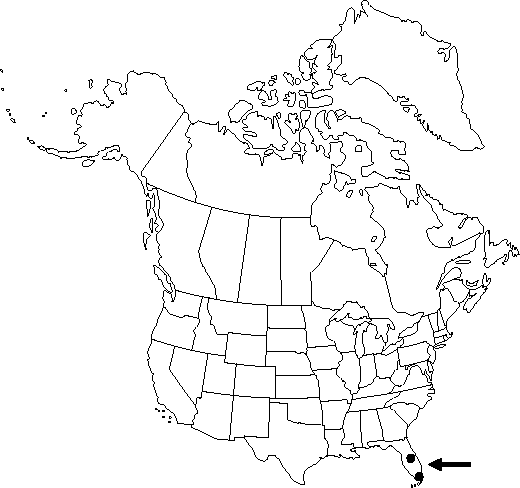Difference between revisions of "Pilea trianthemoides"
Coll. Bot., plate 4 and text on facing page. 1821.
FNA>Volume Importer |
imported>Volume Importer |
||
| (7 intermediate revisions by 2 users not shown) | |||
| Line 11: | Line 11: | ||
|label=Introduced | |label=Introduced | ||
}} | }} | ||
| − | |basionyms={{Treatment/ID/ | + | |basionyms={{Treatment/ID/Basionym |
| − | |name= | + | |name=Urtica trianthemoides |
|authority=Swartz | |authority=Swartz | ||
| + | |rank=species | ||
| + | |publication_title=Kongl. Vetensk. Acad. Nya Handl. | ||
| + | |publication_place=8: 68. 1787 | ||
}} | }} | ||
|synonyms= | |synonyms= | ||
| Line 23: | Line 26: | ||
}}<!-- | }}<!-- | ||
| − | --><span class="statement" id="st- | + | --><span class="statement" id="st-undefined" data-properties=""><b>Shrubs </b>or subshrubs, 1.5-5 dm. <b>Stems</b> 10-30-branched, erect or diffusely ascending. <b>Leaf</b> blades with members of pair unequal, the larger obovate, 5-10 × 4-6 mm, the smaller nearly orbiculate to orbiculate-cordate, 2-5 mm wide, margins entire. <b>Inflorescences</b> crowded. <b>Flowers</b> ca. 0.3-0.5 mm across. <b>Achenes</b> uniformly light brown, slightly compressed, ovoid-cylindric, ca. 0.7 × 0.5 mm, pebbled.</span><!-- |
-->{{Treatment/Body | -->{{Treatment/Body | ||
| Line 29: | Line 32: | ||
|habitat=Waste places, moist thickets, persisting after cultivation | |habitat=Waste places, moist thickets, persisting after cultivation | ||
|elevation=0-20 m | |elevation=0-20 m | ||
| − | |distribution=Fla.;West Indies | + | |distribution=Fla.;West Indies. |
| − | |discussion=<p>The group including Pilea microphylla and P. trianthemoides is in need of taxonomic study. Although in the United States these two species generally can be separated without difficulty, in the West Indies they appear to intergrade. In the West Indies, P. trianthemoides is sometimes treated as P. microphylla var. trianthemoides (Swartz) Grisebach.</p><!-- | + | |introduced=true |
| − | --><p>The name Pilea serpyllifolia (Poiret) Weddell was misapplied to this taxon by J. K. Small.</p> | + | |discussion=<p>The group including <i>Pilea microphylla</i> and <i>P. trianthemoides</i> is in need of taxonomic study. Although in the United States these two species generally can be separated without difficulty, in the West Indies they appear to intergrade. In the West Indies, <i>P. trianthemoides</i> is sometimes treated as <i>P. microphylla</i> var. trianthemoides (Swartz) Grisebach.</p><!-- |
| + | --><p>The name <i>Pilea</i> serpyllifolia (Poiret) Weddell was misapplied to this taxon by J. K. Small.</p> | ||
|tables= | |tables= | ||
|references= | |references= | ||
| Line 40: | Line 44: | ||
-->{{#Taxon: | -->{{#Taxon: | ||
name=Pilea trianthemoides | name=Pilea trianthemoides | ||
| − | |||
|authority=(Swartz) Lindley | |authority=(Swartz) Lindley | ||
|rank=species | |rank=species | ||
|parent rank=genus | |parent rank=genus | ||
|synonyms= | |synonyms= | ||
| − | |basionyms= | + | |basionyms=Urtica trianthemoides |
|family=Urticaceae | |family=Urticaceae | ||
|phenology=Flowering all year. | |phenology=Flowering all year. | ||
|habitat=Waste places, moist thickets, persisting after cultivation | |habitat=Waste places, moist thickets, persisting after cultivation | ||
|elevation=0-20 m | |elevation=0-20 m | ||
| − | |distribution=Fla.;West Indies | + | |distribution=Fla.;West Indies. |
|introduced=true | |introduced=true | ||
|reference=None | |reference=None | ||
| Line 56: | Line 59: | ||
|publication year=1821 | |publication year=1821 | ||
|special status=Introduced | |special status=Introduced | ||
| − | |source xml=https:// | + | |source xml=https://bitbucket.org/aafc-mbb/fna-data-curation/src/2e0870ddd59836b60bcf96646a41e87ea5a5943a/coarse_grained_fna_xml/V3/V3_1030.xml |
|genus=Pilea | |genus=Pilea | ||
|species=Pilea trianthemoides | |species=Pilea trianthemoides | ||
| − | |||
| − | |||
| − | |||
| − | |||
| − | |||
| − | |||
| − | |||
| − | |||
| − | |||
| − | |||
| − | |||
| − | |||
| − | |||
| − | |||
| − | |||
| − | |||
| − | |||
}}<!-- | }}<!-- | ||
-->[[Category:Treatment]][[Category:Pilea]] | -->[[Category:Treatment]][[Category:Pilea]] | ||
Latest revision as of 21:45, 5 November 2020
Shrubs or subshrubs, 1.5-5 dm. Stems 10-30-branched, erect or diffusely ascending. Leaf blades with members of pair unequal, the larger obovate, 5-10 × 4-6 mm, the smaller nearly orbiculate to orbiculate-cordate, 2-5 mm wide, margins entire. Inflorescences crowded. Flowers ca. 0.3-0.5 mm across. Achenes uniformly light brown, slightly compressed, ovoid-cylindric, ca. 0.7 × 0.5 mm, pebbled.
Phenology: Flowering all year.
Habitat: Waste places, moist thickets, persisting after cultivation
Elevation: 0-20 m
Distribution

Introduced; Fla., West Indies.
Discussion
The group including Pilea microphylla and P. trianthemoides is in need of taxonomic study. Although in the United States these two species generally can be separated without difficulty, in the West Indies they appear to intergrade. In the West Indies, P. trianthemoides is sometimes treated as P. microphylla var. trianthemoides (Swartz) Grisebach.
The name Pilea serpyllifolia (Poiret) Weddell was misapplied to this taxon by J. K. Small.
Selected References
None.